
What is Pervious Concrete?
Pervious concrete is just as the name implies – it’s a pavement application that allows stormwater through it so that it can seep into the ground. It’s made in a similar fashion to standard concrete, but without sand or water. Excluding sand and water in the mixture creates voids in the material that allows water to pass through. These voids typically account for 15-25% of the area once it’s hardened.
Although pervious concrete has been around for centuries, it’s only gained popularity in the United States in the last 50 years. It actually gained popularity in Europe after World War II due to a shortage of cement.
What are the benefits of pervious concrete?
There are a lot of benefits to using pervious concrete, namely reducing the amount of stormwater runoff that makes its way into the sewers. While this may sound harmless, runoff water picks up a good deal of surface pollutants along the way before it reaches the sewer.
Because pervious concrete reduces the amount of pollution in the water, the EPA (Environmental Protection Agency) named it a Best Management Practice for Stormwater.
While the chief benefit is its pollution reduction, there’s plenty more upside to using pervious concrete. Reducing surface water means fewer puddles and – in colder climates – fewer icy spots in the cold winter months. Conversely, its light color reduces the amount of heat stored, thus maintaining a lower surface temperature than standard concrete. That means safer walkways and driveways all year.
Pervious concrete is also better for surrounding landscaping, like grass and trees. When the water seeps back into the ground, it supplies the surrounding root systems with valuable water that it would not otherwise get.
Where can pervious concrete be used?
Pervious concrete has been most widely used as a pavement material, so concrete contractors are increasingly using it for driveways and walkways. However, it’s worth noting that because of its porous construction, pervious concrete will potentially degrade faster in high-traffic areas.
Don’t let that be a deterrent for you, though. The benefits of using pervious concrete far outweigh the drawbacks. In fact, many cities and towns throughout the United States have begun utilizing pervious concrete for their municipally-owned areas like parks, parking lots, and public walkways.
That it reduces the amount of water and ice that can form at the surface has made pervious concrete an appealing option for roadways as well. Reducing the number of accidents caused by hydroplaning through water or losing control on ice is an immediate benefit to any public roadway.
Keep in mind that there is a bit of maintenance that comes with using pervious concrete. Regular cleaning of the area helps the concrete maintain those voids that allow water to pass through. Again, the long-term benefits of going with pervious concrete for your driveway or walkway should outweigh any drawbacks.
If you’re interested in further exploring pervious concrete, talk to your concrete contractor or concrete company about it. They can help you decide if it’s viable for your specific use case and help you weigh the benefits of pervious concrete versus other options that are available.
